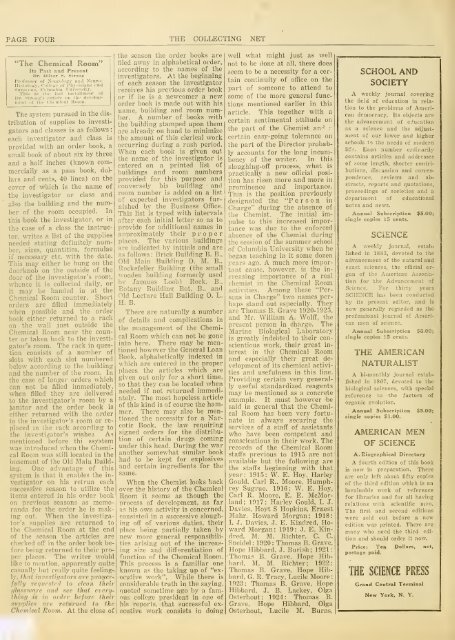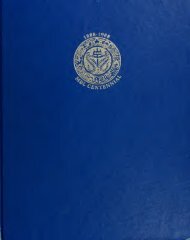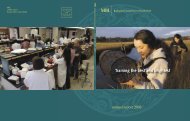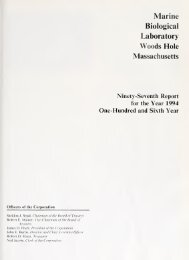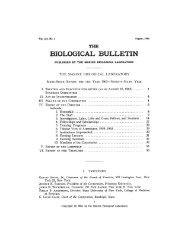View/Open - HPS Repository - Marine Biological Laboratory
View/Open - HPS Repository - Marine Biological Laboratory
View/Open - HPS Repository - Marine Biological Laboratory
- No tags were found...
You also want an ePaper? Increase the reach of your titles
YUMPU automatically turns print PDFs into web optimized ePapers that Google loves.
::PAGE FOUR THE COLLECTING NET"The ChemicalRoom"Its Past and PresentI)r. Olivir S. !S(ronBProfussor of Xcurolujjy and Neuroilistiilogy,Oolli't'C (it I'hjsieiaiis i:ncl•Sur^^cous, C(»!uinl)ia t'nivt'rsit.v.Tills is the last iiistallmout ofDr. StroiiK's artii/li" on Ihu Uevoloyniratof thv Chemical Uiioni.The system pursued in the distributionof supplies to investigatorsand classes is as followseach investigator and class isprovided with an order book, asmall book of about six by threeand a half inches (known commerciallyas a pass book, dollarsand cents, 40 lines) on thecover of which is the name ofthe investigator or class andalso the building and the numberof the room occupied. Inthis book the investigator, or inthe case of a class the instructor,writes a list of the suppliesneeded stating definitely number,sizes, quantities, formulaeif necessary etc. with the date.This may either be hung on thedoorknob on the outside of thedoor of the investigator's room,whence it is collected daily, orit may be handed in at theChemical Room counter. Shortorders are filled immediatelywhen possible and the orderbook either returned to a rackon the wall just outside theChemical Room near the counteror taken back to the investigator'sroom. The rack in questionconsists of a number ofslots with each slot numberedbelow according to the buildingand the number of the room. Inthe case of longer orders whichcan not be filled immediately,when filled they are deliveredto the investigator's room by ajanitor and the order book iseither returned with the orderto the investigator's room or replacedm Ihe rack according tothe investigator's wishes Asmentioned before thi ssy.stemwas introduced when the ChemicalRoom was still located in thebasement of the Old Main Building.One advantage of thissystem is that it enables the investigatoron his retrun eachsuccessive season to utilize theitems entered in his order bookon previous seasons as memorandafor the order he is makingout. When the investigator'ssupplies are returned tothe Chemical Room at the endof the season the articles arechecked off in the order book beforebeing returned to their properplaces. The writer wouldlike to mention, apparently quitecasually but really quite feeling-,ly, that investigators are prayerfulhjrequested to clea,n theirplnssware and see that everythingis in order before theirsupplies are returned to theChemical Room. At the close ofthe season the order books arefiled away in alphabetical order,accoi'ding to the names of theinvestigators. At the beginningof each season the investigatorreceives his pre\'ious order bookor if he is a newcomer a neworder book is made out with hisname, building and room number.A number of books withthe building stamped upon themare already on hand to minimizethe amount of this clerical workoccurring during a rush period.When each book is given outthe name of the investigator isentered on a printed list ofbuildings and room numbersprovided for this purpose andconversely his building androom number is added on a listof expected investigators furnishedby the Business Office.This list is typed with intervalsafter each initialletter so as toprovide for additional names inapproximately their properplaces. The various buildingsare indicated by initials and areas follows: Brick Building B. B.,Old Main Building 0. M. B.,Piockefeller Building (the smallwooden building formerly usedbv Jacques Loeb) Rock. B.,Botany Building Bot. B., andOld Lecture Hall Building 0. L.H. B.There are naturally a numberof details and complications inthe management of the ChemicalRoom which can not be goneinto here. There may be mentionedhowever the General LoanBook, alphabetically indexed inwhich are entered in the properplaces the articles which aregiven out only for a short time,so that they can be located whenneeded if not returned immediately.The most hopeless articleof this kind is of course the hammer.There may also be mentionedthe necessity for a NarcoticBook, the law requiringsigned orders for the distributionof certain drugs comingunder this head. During the waranother somewhat similar bookhad to be kept for explosivesand certain ingredients for thesame.When the Chemist looks backover the history of the ChemicalRoom it seems as though theprocess of development, as faras his own activity is concerned,consisted in a successive sloughingoff of various duties, theirplace being partially taken bynew more general responsibilitiesarising out of the increasingsize and differentiation offiinction of the Chemical Room.This process is a familiar oneknown as the taking up of "executivework". While there isconsiderable truth in the saying,quoted sometime ago by a famouscollege president in one ofhis reports, that successful executivework consists in doingwell what might just as wellnot to be done at all, there doesseem to be a necessity for a certaincontinuity of office on thepart of someone to attend tosome of the more general functionsmentioned earlier in thisarticle. This together with acertain sentimental attitude onthe part of the Chemist an'' .-certain easy-going tolerance onthe pai-t of the Director probablyaccounts for the long incumbencyof the writer. In thi.ssloughing-off process, what ispractically a new official positionhas risen more and more inprominence and importance.This is the position previouslydesignated the "P e r s o n inCharge" during the absence ofthe Chemist. The initial impulseto this increased importancewas due to the enforcedabsence of the Chemist duringthe session of the summer schoolof Columbia University when hebegan teaching in it some dozenyears ago. A much more importantcause, however, is the increasingimportance of a realchemist in the Chemical Roomactivities. Among these "Personsin Charge" two names perhapsstand out especially. Theyare Thomas B. Grave 1920-1925,and Mr. William A. Wolff, thepresent person in charge. The<strong>Marine</strong> <strong>Biological</strong> <strong>Laboratory</strong>isgreatly indebted to their conscientiouswork, their great interestin the Chemical Roomand especially their great developmentof its chemical activitiesand usefulness in this line.Providing certain very generallyuseful standardized reagentsmay be mentioned as a concreteexample. It must however besaid in general that the ChemicalRoom has been very fortunatein always securing theservices of a staff of assistantswho have been competent andconscientious in their work. Therecords of the Chemical Roomstaffs previous to 1915 are notavailable but the following arethe staffs beginning with thatyear: 1915: W. E. Hoy, HarleyGould, Carl R.. Moore, HumphreySugrue. 1916: W. E. Hoy,Carl R. Moore, E. E. McMorland;1917: Harley Gould, I. J.Davies, Hoyt S Hopkins, ErnestMahr, Howard Morgan; 1918:I. J. Davies, J. E. Kindred, HowardMorgan; 1919: J. E. Kindred,M. M. Richter, C. C.Speidel : 1920 : Thomas B. Grave,Hope Hibbard, J. Burish; 1921:•Thomas B. Grave, Hope Hibbard,M. M. Richter; 1922:Thomas B. Grave. Hope Hibbard,G. R. Tracy, Lucile Moore1923: Thomas B. Grave, HopeHibbard, J. B. Lackey, OlgaOsterhout; 1924: Thomas B.Grave, Hope Hibbard, OlgaOsterhout, Lucile M. Burns,SCHOOL ANDSOCIETYA weekly journal coveringthe field of education in relationto the problems of Americandemocracy. Its objects arethe advancement of educationas a science and the adjustmentof our lower and higherschools to the needs of modernlife. Eacii number ordinarilycontains articles and addressesof some length, shorter contributions,discussion and correspondence,reviews and abstracts,reports and quotations,proceeding's of societies and adepartment of educationalnotes and news.Annual Subscription $5.00;single copies 15 cents.SCIENCEA weekly journal, establishedin 1883, devoted to theadvancement of the natural andexact sciences, the official organof the American Associationfor the Advancement ofScience. For thirty yearsSCIENCE has been conductedby its present editor, and isnow generally regarded as theprofessional journal of Americanmen of science.Annual Subscription $6.00;single copies 15 cents.THE AMERICANNATURALISTA bi-monthly journal establishedin 1867, devoted to thebiological sciences, with specialreference to the factors ofoi'ganicevolution.Annual Subscription $5.00;single copies $1.00.AMERICAN MENOF SCIENCEA. Biographical DirectoryA fourth edition of this bookis now in preparation. Thereare only left about fifty copiesof the third edition which is aninvaluable work of referencefor libraries and for all havingrelations with scientific men.The first and second editionswere sold out before a newedition was printed. There aremany who need the third editionand should order it now.Price: Ten Dollars, net,postage paid.THE SCIENCEPRESSGrand Central TerminalNew York, N. Y.


